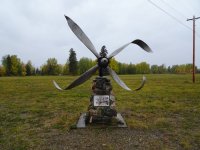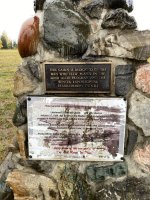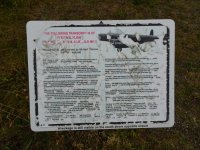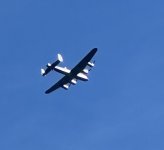Interesting, but I don't think they were equipped with the No. 4 Mk I in 1919. As a stand in for the No. I Mk III I can understand.Donated by Canada in 2019 on the centenary of the establishment of the Latvian Army following WWI, which at the time was equipped with British equipment, including the No.4 Mk I.
You are using an out of date browser. It may not display this or other websites correctly.
You should upgrade or use an alternative browser.
You should upgrade or use an alternative browser.
Picture of the day
- Thread starter jwhc
- Start date
Interesting, but I don't think they were equipped with the No. 4 Mk I in 1919. As a stand in for the No. I Mk III I can understand.
Yes, of course. Thanks for pointing that out. Its my understanding that at the time Latvia had a mix of Enfield rifles from that period (obviously not the No.4 Mk I).
Last edited:
That's a modern photo, look at the synthetic police vests and synthetic flag material.With No. 4 rifles...
Those rifles appear to be No4 models, a couple with pig sticker bayonets attached.
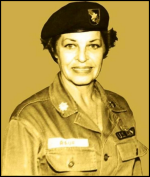
How does a woman become both a Colonel in the US Marines and a Lieutenant Colonel in the US Army and a Green Beret? Well you just needed to be Martha Raye! Due to her work with the Military with her USO shows, she was made an honorary member of the US Marines and the US Army and even a honorary Green Beret. But she even helped medics in the field under fire while there and was wounded twice!
She's even made 5 jumps with the Green Berets (training of course).
Her work spanned WWII, Korea, and Vietnam!
In 1993 she was awarded the Presidential Medal of Freedom for her efforts.
She was even buried at Fort Bragg in the Main Post cemetery, the only civilian (that I can find) to be buried there.
Some of those planes are still missing and lying in the bush somewhere between Edmonton and Siberia.Displays at the Watson Lake Airport
View attachment 821479
View attachment 821482
View attachment 821488
Was just up there last week (post in Photo section about Smith River), and virtually nothing gets cleaned up in that part of the world. The Million Dollar Valley wrecks were only salvaged by Tallichet in the 70s, and part of one fuselage remains. The B36 I posted about in regards to the Smithers Museum is still smeared across the mountain, and same goes for most others. The only reason Million Dollar Valley was initially picked over (engines and guns) was due to the proximity of the Alaska Highway and personnel being available. Other in the bush and lakes were just left, as were a few on mountainsides.I would say anyrthing in the Canadian north or Alaska has been cleaned up unless underwater somewhere.
https://www.explorenorth.com/library/aviation/million_dollar_valley.html
Dark Alley Dan
CGN Ultra frequent flyer
- Location
- Darkest Edmonton
The Lockheed Constellation is one of mankind's most beautiful things. Looks great in blue, too:


Alternate scheme:

I hear they called it a "C-121J". No word on a nickname. Sure as hell not "Fat Albert".


Alternate scheme:

I hear they called it a "C-121J". No word on a nickname. Sure as hell not "Fat Albert".
The "Connie" is my all time favorite aircraft.
It is the first aircraft I had the pleasure of flying in. I was six years old at the time and it looked massive when we first walked out onto the passenger loading area and that climb up the passenger "ramp" seemed to quite a challenge as the steps were steep and an uncomfortable stretch for my short legs.
When the engines started, the whole plane "vibrated" and the noise had to be heard to be believed. You could feel every crack in the tarmac as the wheels rolled over them, but once it was in the air, the vibrations were barely there and the noise from the engines, landing gear, etc settled down to a rather calming drone, which was easy to be comfortable with.
There was lots of leg room for me back then, but the seats had more space between them than the planes of today.
Everyone who wanted to smoked, whatever they had, pipes, cigars and cigarettes, without concern for any of the other passengers. Alcoholic beverages were offered for a price, meals were included as were soft beverages.
Very exciting times for a six year old boy, who had only dreamed and played at flying before the trip.
Did I mention, I really liked the CONNIE.
Thanx for posting those pics, great memories were brought back from 70 years.
It is the first aircraft I had the pleasure of flying in. I was six years old at the time and it looked massive when we first walked out onto the passenger loading area and that climb up the passenger "ramp" seemed to quite a challenge as the steps were steep and an uncomfortable stretch for my short legs.
When the engines started, the whole plane "vibrated" and the noise had to be heard to be believed. You could feel every crack in the tarmac as the wheels rolled over them, but once it was in the air, the vibrations were barely there and the noise from the engines, landing gear, etc settled down to a rather calming drone, which was easy to be comfortable with.
There was lots of leg room for me back then, but the seats had more space between them than the planes of today.
Everyone who wanted to smoked, whatever they had, pipes, cigars and cigarettes, without concern for any of the other passengers. Alcoholic beverages were offered for a price, meals were included as were soft beverages.
Very exciting times for a six year old boy, who had only dreamed and played at flying before the trip.
Did I mention, I really liked the CONNIE.
Thanx for posting those pics, great memories were brought back from 70 years.
The muskeg is vast and deep.I would say anything in the Canadian north or Alaska has been cleaned up unless underwater somewhere.
https://www.explorenorth.com/library/aviation/million_dollar_valley.html
https://lend-lease.net/articles-en/yukon-cobra-rediscovered/
Dark Alley Dan
CGN Ultra frequent flyer
- Location
- Darkest Edmonton
Sad story, Griz. But a very nice '94 there. 
The Soviets loved the P-39.

The Soviets loved the P-39.

True, I was told the barrel of a Sherman is still sticking out of the muskeg north of FSJ, was lost during the war and just left.The muskeg is vast and deep.
fat tony
CGN Ultra frequent flyer
That's a Schwarzlose delayed blowback heavy machine gun. It had a short barrel compared to other WWI hmg's and sported an enormous cone flash arrestor. I do not know or recall if they required case lubrication. The mode of operation probably dictated the short barrel and huge flash arrestor.
From what I have read, the cartridges did require lubrication. Also, it was one of the slowest firing and least reliable HMGs produced during WW1.That's a Schwarzlose delayed blowback heavy machine gun. It had a short barrel compared to other WWI hmg's and sported an enormous cone flash arrestor. I do not know or recall if they required case lubrication. The mode of operation probably dictated the short barrel and huge flash arrestor.
fat tony
CGN Ultra frequent flyer
I read it was not suitable for aircraft use, ground use - it was reliable. Just look at the list of users and wars it was used in.From what I have read, the cartridges did require lubrication. Also, it was one of the slowest firing and least reliable HMGs produced during WW1.
It was adapted, modified, and built under license throughout its service life. With the substitution of some parts it could be given a higher rof, eventually up to 860 rpm (aircraft guns) with the substitution of a new operating spring.
For aerial use, it fell out of favour. Interestingly blowback autocannons showed up in the world's air forces in WWII and beyond.

Caption:
British soldiers seize a Schwarzlose machine gun from a Jewish weapons cache during the 1947–48 Civil War in Mandatory Palestine.
Last edited:
Dark Alley Dan
CGN Ultra frequent flyer
- Location
- Darkest Edmonton
Four Merlins in close order. Magnificent.
Here's one I didn't know about - a kind of "Teutonic Anson" - the FW 58 "Weihe":




1300+ built, three remaining - one in a museum in Brazil, another in storage in Norway, and the third at the bottom of a French lake.
Here's one I didn't know about - a kind of "Teutonic Anson" - the FW 58 "Weihe":



1300+ built, three remaining - one in a museum in Brazil, another in storage in Norway, and the third at the bottom of a French lake.















































